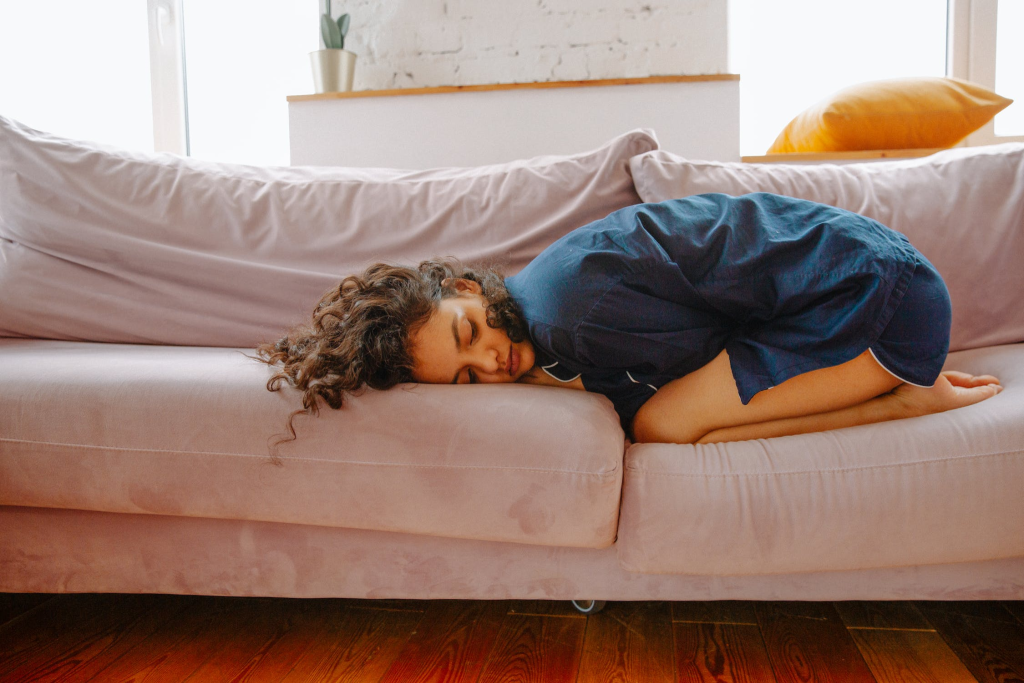Menstrual cramps and PMS hurt a lot because of hormones and body changes..This pain occurs due to natural chemicals called prostaglandins produced in the uterine lining. Prostaglandins prompt the muscles and blood vessels in the uterus to contract, causing discomforts.
Feeling bloated and retaining water also adds to the ouch. Some things like genes and how we live affect how much it hurts. If it hurts badly or feels weird, a doctor can help figure it out and make it better.
Here are some explanations and tips that you might find helpful if you’re experiencing PMS and menstrual cramps.
Taming Period Pain: Dealing with Cramps and PMS
Muscles Squeezing and Cramps
Menstrual cramps, scientifically known as dysmenorrhea, are common and can be pretty uncomfortable. They usually happen because of these hormone-like substances called prostaglandins. Prostaglandins can sometimes tell the muscles in your uterus to contract really hard.
That’s when you feel those cramps – it’s like an achy or painful sensation, and it often comes with your period. These cramps happen because your body is busy shedding the old lining of your uterus, like a cleaning process. So, it’s like your body is doing some spring cleaning, and these cramps are part of it.
You may feel like you can’t tolerate the pain, but you can actually do something so it won’t feel so bad.
Here are some ways to manage them:
1. Heat Therapy
Heat therapy is a simple trick that might help you feel better when a bothersome period comes. This means putting a warm, cozy hot water bottle or heating pad on your stomach. It’s like giving your tummy a warm hug.
This warmth can make the muscles in your tummy relax and give you some relief from those cramps. So, next time you feel uncomfortable, grab a heating pad and give it a try – your tummy will thank you.
2. Over-the-Counter Pain Relievers
Medications like naproxen or ibuprofen can help you reduce pain and inflammation. Always follow the dosing instructions and consult an adult or a loved one before taking any medication if you’re a minor.
3. Exercise
Physical activity, like walking, swimming, and aerobic exercises, releases endorphins, or hormones that block that pain feeling. It will also improve blood flow and ease cramps..
4. Hydration and Nutrition
Drinking lots of water to keep hydrated and eating healthy foods is like giving your body the right fuel. Imagine your body as a superhero needing good food to fight cramps. Fruits, veggies, and whole grains are its sidekicks! They team up to keep your body strong and make those cramps less bothersome.
So, remember to drink water and munch on colorful fruits and veggies – your body will be ready to take on anything!
Premenstrual Syndrome (PMS)
PMS refers to a range of emotional and physical symptoms you feel before menstruation comes. These symptoms are influenced by hormonal changes and can vary from person to person. They are usually identified as mood swings and grumpiness.
Those same tricky hormones can also affect how you feel emotionally. Have you ever noticed that sometimes you feel a bit grumpy or sad before your period starts? Well, those hormones play a role in making your moods swing up and down.
But don’t worry, there’s an incredible tool called a period calculator that can help you track symptoms and predict when your period will likely show up. It can help you keep an eye on the symptoms of PMS and better prepare yourself in cases of ill-effects.
It’s not your fault if you’re feeling more emotional than usual – it’s just your body doing its thing. Here are some tricks to help you manage PMS:
5. Healthy Lifestyle
Maintaining regular exercise, sufficient sleep, and a balanced diet can help manage and regulate PMS symptoms and improve overall well-being.
Regular exercise means moving your body in fun ways, like walking, swimming, or playing a sport – like a body adventure. Aim for a good night’s sleep, like letting your body recharge. A balanced diet is like a rainbow on your plate: colorful fruits, veggies, whole grains, and protein, like lean meats or beans, can help reduce PMS symptoms.
These lifestyle changes help your body stay strong and make PMS symptoms feel like less of a challenge.
6. Stress Management
Relaxation techniques like yoga, deep breathing, or meditation can help reduce stress and manage PMS symptoms.
7. Dietary Changes
Reducing caffeine, salty foods, and sugary snacks before your period might help alleviate bloating and mood swings.
8. Medical Advice
Seeing a doctor is a good idea if your symptoms become severe and already interfere with your daily life. They can provide tailored advice and may recommend hormonal birth control or other treatments if necessary.
Takeaways
Remember, everyone’s body is different. What works for one person might not work for another. It’s essential to listen to your body, be patient with yourself, and seek help when needed. If you have any concerns or questions, don’t hesitate to talk to a healthcare professional.

